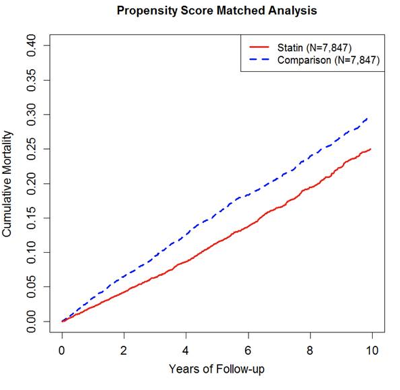Session Information
Session Type: ACR Poster Session C
Session Time: 9:00AM-11:00AM
Background/Purpose: Although the cardinal feature of gout is inflammatory arthritis, it is also a metabolic condition closely associated with an elevated uric acid burden and insulin resistance. Thus, gout and hyperuricemia are associated with major cardiovascular (CV)-metabolic-renal comorbidities and their sequelae. Statins confer both CV and survival benefits in both individuals with and without CVD; however, the impact of statins in gout remains unknown. We examined the potential survival benefit of statin use among gout patients in a general population context.
Methods: We performed an incident user cohort study with time-stratified propensity score matching using an electronic medical record database representative of the UK general population. The study population included individuals aged ≥20 years who had a diagnosis of gout between January 1999 and December 2014. To account for potential confounders, we compared propensity score-matched cohorts of statin initiators and non-initiators within 1-year cohort accrual blocks. The variables used to create the propensity score model included disease duration, body mass index, lifestyle factors, duration of gout, CV comorbidities, and medication use, including anti-gout medications. We estimated the mortality hazard ratio of statin initiation using Cox proportional hazard models and the mortality rate difference using an additive hazard model.
Results: After propensity score matching, the baseline characteristics were well-matched between the two groups. Among 17,018 statin initiators, 2,503 deaths occurred during the follow-up period (mean=5.0 years), resulting in an all-cause mortality rate of 23.97/1000 person-years (PY). The corresponding number of deaths and all-cause mortality rate among the 17,018 matched comparators during the follow-up period (mean=4.6 years) were 2,025 and 31.67/1000 PY, respectively. As such, all-cause mortality during the follow-up period was lower among the statin initiators than among the comparators (see Figure). Compared with non-initiators, statin initiators experienced a 16% lower relative rate of all-cause mortality (HR=0.84, 95% CI 0.79 to 0.89) and a rate difference of 7.7 (95% CI 6.1 to 9.3) fewer deaths per 1000 PY. The protective association between statin initiation and all-cause mortality persisted across subgroups, including age (age <60, HR=0.85; age 60-70, HR=0.81; age >70, HR=0.85), sex (males, HR=0.82; women, HR=0.88), and socioeconomic status (low, HR=0.82; high, HR=0.86).
Conclusion: In this general population-based cohort study, we found that statin initiation is associated with a lower risk of mortality among gout patients. The magnitude of this inverse association (i.e., a 16% reduction) appears at least comparable to or greater than that found in the general population where statins are used for primary prevention.
To cite this abstract in AMA style:
Keller S, Rai SK, Lu N, Oza A, Zhang Y, Choi HK. Statin Use and Mortality in Gout: A General Population-Based Cohort Study [abstract]. Arthritis Rheumatol. 2017; 69 (suppl 10). https://acrabstracts.org/abstract/statin-use-and-mortality-in-gout-a-general-population-based-cohort-study/. Accessed .« Back to 2017 ACR/ARHP Annual Meeting
ACR Meeting Abstracts - https://acrabstracts.org/abstract/statin-use-and-mortality-in-gout-a-general-population-based-cohort-study/

